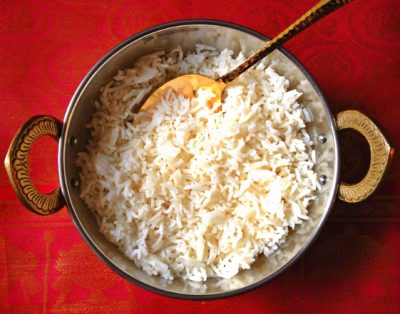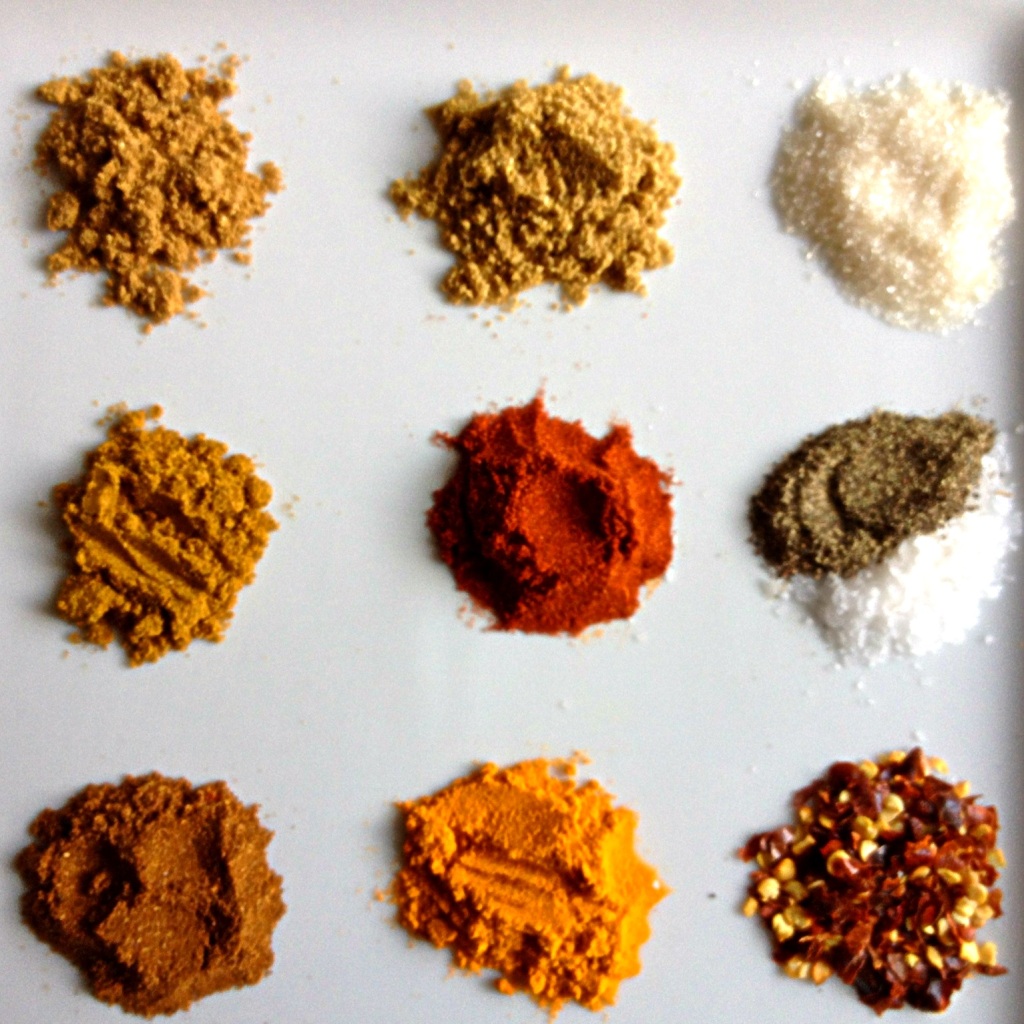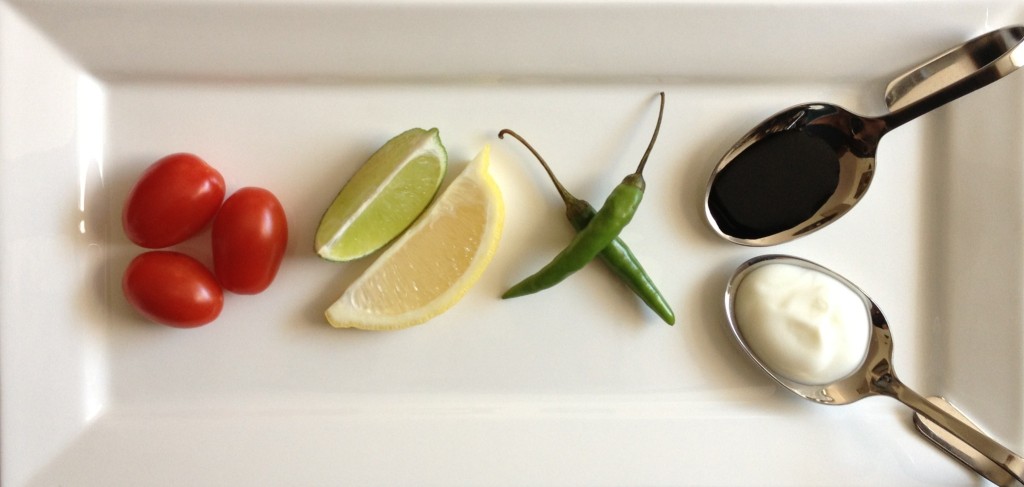All You Really Need: basic aromatics, spices, and herbs you need in your pantry and fridge
Alright, let’s get down to business in terms of your kitchen. To make a variety of authentic Indian dishes at home, you need a few key things in your pantry and fridge.
First, you won’t put all of these ingredients into one dish! For many recipes you may only need 1-3 spices, perhaps 4-6 spices in more advanced recipes.
Second, there are hundreds of more spices and herbs in Indian cuisine — these are the main items you need to be set for a while. Plus, the upside is that you can find ALL of these at your local grocery store, you don’t need to go a specialty grocer.
Third, you may already have many of the ingredients you need at home — like cumin powder, especially if you use it for spice rubs or making chili!
In the course of teaching Sean the basics of Indian cooking, I developed foolproof cheat sheets and primers to help ANYONE make authentic Indian dishes at home. You will see that I usually recommend things in multiples of “5” — so five of this or ten of that or 5 ingredients or 10 key steps. Honestly, it’s just easy to remember. I thought a lot about this in order to make it stick and help Sean remember — here is my solution. If you have these key things you can never go wrong. Most of them you can buy every few months and store in your cupboard or pantry. I created this ‘bare essentials’ list for Sean.
The 5 — 10 — 5 Rule
5 AROMATICS
Onions – Ginger Root – Garlic Cloves – Fresh Mint – Fresh Cilantro
10 GROUND SPICES
Cumin – Coriander – Sugar – Curry – Paprika – Salt – Pepper – Garam Masala – Turmeric – Red Chilli
5 WHOLE SPICES
Green Cardamom – Cloves – Mustard seeds – Cinnamon Stick – Cumin seeds
Let’s add one more group of “5”
Don’t worry, I swear I’m not making it more complicated when I’ve promised you to make it simple and easy to follow! These are the 5 ingredients that you likely already have at home or would drop into your shopping cart anyway:
5 REFRIGERATOR & PANTRY
Tomatoes – Lemon/Lime – Fresh Chilli – Vinegar – Yogurt
North India & South India
Now it’s important to point out that the “5 — 10 — 5″ rule above applies mostly to dishes from northern India — the dishes you are used to eating in restaurants, especially if you aren’t South Asian. As you can see in the post Indian Cuisine Map with its 28 states in a land area the same size as Europe, the Indian subcontinent is host to many different regional cuisines that are quite different, but 80-90% of restaurants outside of India feature cuisine from the north. It’s not even really accurate for me to divide everything between the north and south only, but it is a very helpful distinction when thinking broadly about Indian cuisine. Stay tuned for my forthcoming post on the “5 — 10 — 5″ rule for South Indian cuisine.







Hey, I read your article and your information are such great and amazing it is so much helpful for me. Thank you so much:)
Just seeing this in 2020 and so thankful for it! It’s helped me feel a lot more equipped to begin tackling the world of spices in Indian food!
Dear Meghan,
Thank you for visiting Big Apple Curry! Your comment made our day! Given everything we are all facing, the fact that we’ve helped you in any small way means the world to us. There is such an exciting world of discovery in Indian cuisine, and we hope you will enjoy the ride. Please let us know what you make and send us photos, we would love to see it!
With warmest wishes,
Ina
This 5-10-5 rule is simply the best basic approach to indian cuisine I’ve seen. Im just getting into it, and love my curried chicken and lamb. There is an Indian spice store close by and they have everything for a fraction of supermarket prices, and (I think) fresher.
Dear Dennis!
You made my day! I created the 5-10-5 cheat sheet after thinking about it for years, and my goal was to make it as easy as possible. I’m delighted to hear about your foray into Indian cooking — I’ve shared my most favorite recipes here at Big Apple Curry, recipes that are tried and tested and I’ve made several times. If you have an Indian store nearby, even better — you can make a wide variety of dishes and I have a feeling you will be a pro in no time!
With warmest wishes,
Ina
overall, i liked this post a lot, its a nice way of organizing spices since I’m just learning to cook indian food. but i have some complaints:
I would have omitted sugar and salt as spices, since they are not. Also I prefer whole garam masala.
I would have added bay leaf, tamarind paste, saffron, asafoetida powder, whole nutmeg (these are essential in my view!). I think pepper should be whole peppercorns in a grinder for versatility.
Indian cooking is so diverse though, it probably depends all on your region/family/personal style
Dear Poornima,
Thank you for visiting Big Apple Curry! I’m glad you like the post. You’re quite right, salt and sugar are not technically ground spices, as salt is considered a ‘mineral’ and sugar is essentially ‘glucose’ that sweetens rather than adds flavor. As you say, Indian cooking is so diverse. With such a richly complex subcontinent with many regional approaches to cooking, what’s considered ‘key spices’ can differ from household to household!
Two main things regarding our 5-10-5 Rule:
i) I created this for Indian Cooking beginners and provide them with the most basic cheat sheet to make authentic Indian dishes showing them how to leverage items they may already have at home (like salt, sugar, tomatoes, etc); I’ve included main elements of whole garam masala (like cinnamon stick, cardamom pods, and cloves) under the 5 whole spices; and,
ii) I chose items (like whole garam masala) that would readily be available in the spice section at any grocery store. The idea is one wouldn’t have to make a trip to the Indian store for items like tamarind paste and asafetida.
If you see my 101-401 series of cooking lessons, it takes one from starting out with basic curry powder, and gradually adding ground and whole spices at the 101-301 levels found at most supermarkets, and at the 401 level one would have to visit an Indian grocer for spices like black cumin (jeera).
You’re already more advanced than my 5-10-5 Rule 🙂
Hope this helps!
Ina
Thank you for sharing these great rules! I love experimenting with food of different countries. Hope to get some great inspiration from you. Thanks for sharing
Thought I’d leave a comment here due to twitters limitations.
Oh well. I think that the “madras curry powder” is a typical Anglo-Indian invention. Lots of Indians told me that they basically never use it. But great cheat sheet;)
The curry powder is basically just Garam masala with turmeric added.
Love this idea! Makes it seem much less intimidating to start out.
Hi Alison, glad you think so! These are the basic things I use to make a wide variety of Indian dishes — the ground and whole spices will keep for a long time in your cupboard (1-2 years for ground spices and 3-4 years for whole spices). There are hundreds of additional Indian spices and herbs, but these are the bare essentials anyone would need.